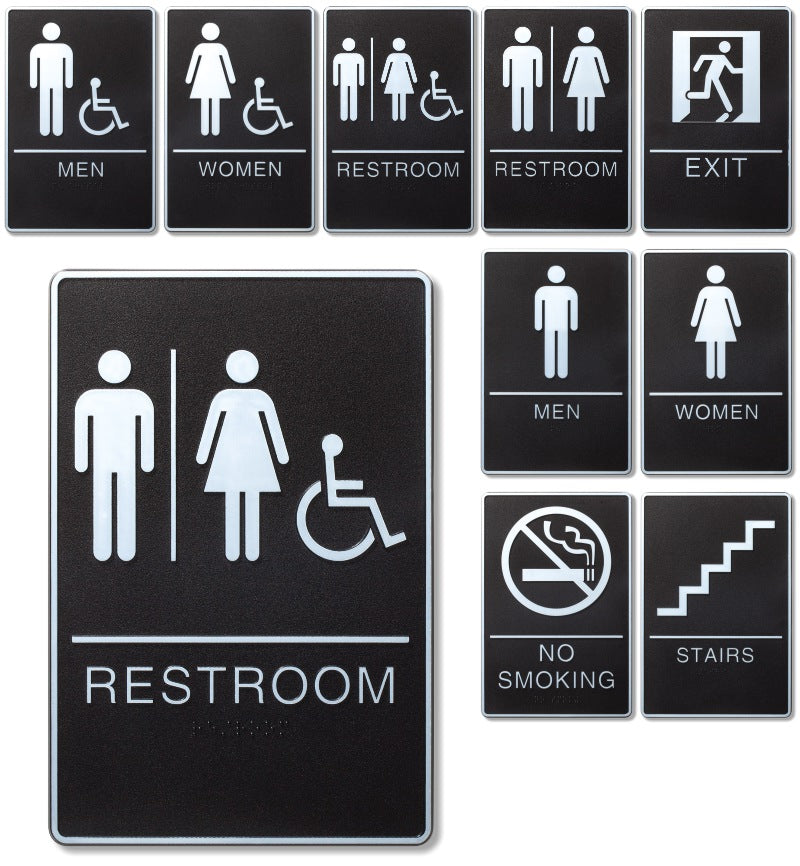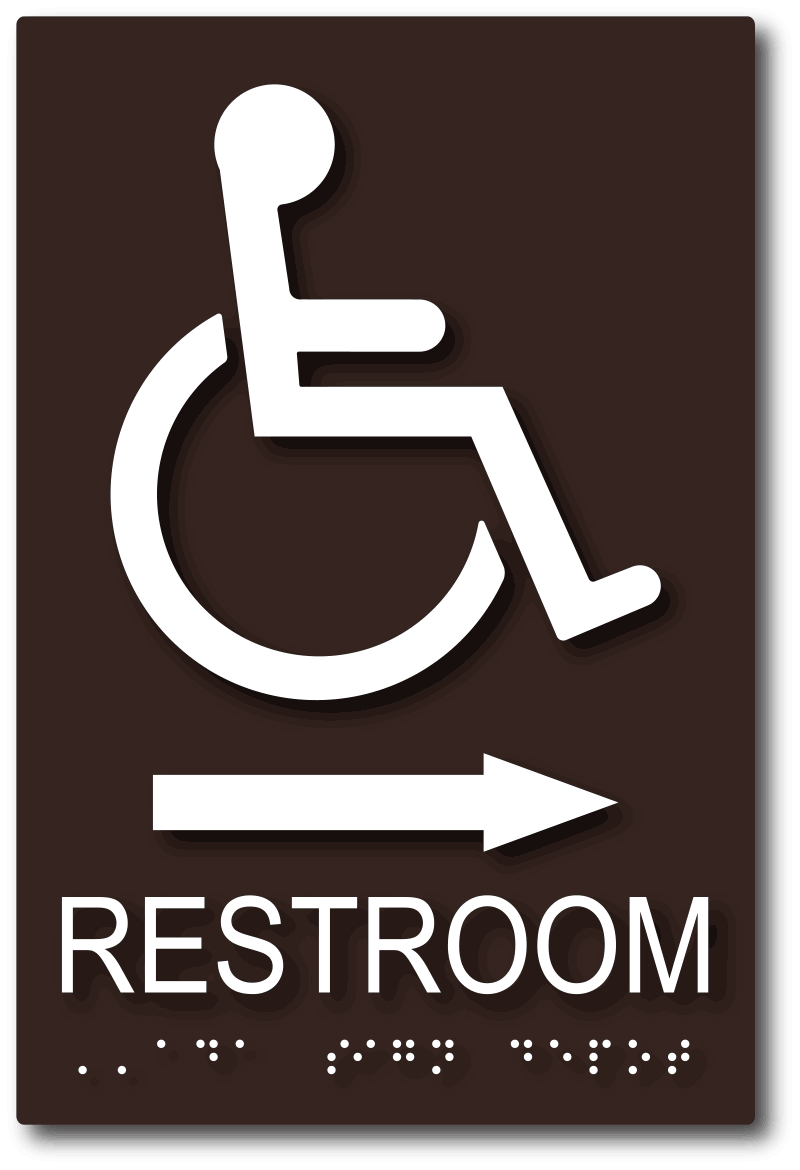Exactly How ADA Signs Enhance Availability for Everyone
Exactly How ADA Signs Enhance Availability for Everyone
Blog Article
Discovering the Key Functions of ADA Indications for Enhanced Ease Of Access
In the realm of accessibility, ADA signs function as silent yet effective allies, making sure that rooms are accessible and comprehensive for individuals with specials needs. By integrating Braille and tactile elements, these signs damage barriers for the aesthetically damaged, while high-contrast color pattern and legible font styles deal with varied aesthetic needs. In addition, their calculated placement is not arbitrary yet rather a calculated effort to facilitate smooth navigation. Yet, beyond these attributes lies a deeper story regarding the evolution of inclusivity and the continuous dedication to developing equitable spaces. What a lot more could these signs indicate in our search of universal accessibility?
Importance of ADA Compliance
Ensuring conformity with the Americans with Disabilities Act (ADA) is crucial for promoting inclusivity and equivalent access in public areas and offices. The ADA, enacted in 1990, mandates that all public centers, companies, and transportation services accommodate individuals with specials needs, ensuring they delight in the exact same civil liberties and opportunities as others. Conformity with ADA standards not only meets legal commitments yet likewise boosts a company's reputation by demonstrating its commitment to variety and inclusivity.
One of the essential facets of ADA conformity is the implementation of easily accessible signage. ADA signs are designed to ensure that individuals with specials needs can easily browse with structures and spaces.
Moreover, adhering to ADA laws can reduce the risk of lawful effects and potential penalties. Organizations that stop working to adhere to ADA standards may deal with legal actions or fines, which can be both damaging and economically troublesome to their public photo. Therefore, ADA conformity is indispensable to promoting a fair setting for every person.
Braille and Tactile Components
The unification of Braille and tactile aspects right into ADA signs embodies the concepts of ease of access and inclusivity. These functions are critical for individuals who are blind or aesthetically impaired, enabling them to navigate public areas with greater independence and self-confidence. Braille, a responsive writing system, is important in providing written info in a style that can be easily regarded with touch. It is generally placed beneath the matching text on signage to ensure that individuals can access the info without aesthetic assistance.
Responsive components prolong past Braille and consist of increased characters and symbols. These parts are developed to be discernible by touch, enabling individuals to determine space numbers, restrooms, departures, and various other vital areas. The ADA sets particular guidelines concerning the size, spacing, and placement of these tactile aspects to enhance readability and ensure uniformity throughout different environments.

High-Contrast Color Pattern
High-contrast color design play an essential role in boosting the exposure and readability of ADA signs for individuals with aesthetic impairments. These systems are crucial as they maximize the distinction in light reflectance between text and history, making sure that signs are quickly discernible, even from a range. The Americans with Disabilities Act (ADA) mandates making use of details color contrasts to suit those with minimal vision, making it a critical element of conformity.
The efficacy of high-contrast shades hinges on their ability to attract attention in numerous lights conditions, consisting of poorly lit settings and areas with glow. Generally, dark text on a light history or light text on a dark background is used to achieve optimal comparison. Black message on a yellow or white background offers a plain aesthetic distinction that aids in quick recognition and understanding.

Legible Fonts and Text Size
When taking into consideration the layout of ADA signage, the choice of legible font styles and ideal message size can not be overstated. The Americans with Disabilities Act (ADA) mandates that typefaces must be not italic and sans-serif, oblique, script, extremely attractive, or of uncommon type.
The dimension of the message likewise plays a critical role in ease of access. According to ADA standards, the minimal text height need to be 5/8 inch, and it needs to boost proportionally with viewing range. This is specifically important in public spaces where signage requirements to be reviewed swiftly and precisely. Consistency in message size adds to a natural aesthetic experience, aiding individuals in browsing settings successfully.
Furthermore, spacing between letters and lines is essential to legibility. Ample spacing avoids characters from appearing crowded, boosting readability. By adhering to these criteria, designers can significantly boost ease of access, making certain that signage serves its desired function for all people, despite their visual abilities.
Effective Positioning Techniques
Strategic placement of ADA signage is crucial for taking full advantage of accessibility and guaranteeing conformity with lawful standards. Correctly positioned indicators guide individuals with specials needs properly, facilitating navigating in public spaces. Secret factors to consider consist of closeness, exposure, and height. ADA standards specify that indicators should be mounted at an elevation between 48 to 60 inches from the ground to ensure they are within the line of sight for both standing and seated individuals. This conventional height variety is essential for inclusivity, making it possible for mobility device customers and people of differing elevations to accessibility details effortlessly.
Furthermore, indicators must be placed surrounding to the latch side of doors to permit simple recognition before entry. Uniformity in sign positioning throughout a facility boosts predictability, decreasing complication and improving total individual experience.

Verdict
ADA indications play a vital function in advertising accessibility by integrating functions that deal with the demands learn the facts here now of individuals with impairments. Integrating Braille and responsive elements guarantees important details is available to the visually impaired, while high-contrast shade systems and understandable sans-serif typefaces enhance exposure across various lights conditions. Effective placement techniques, such as ideal placing elevations and strategic places, even more assist in navigating. These aspects jointly foster an inclusive environment, highlighting the significance of ADA compliance in making sure equal gain access to for all.
In the world of availability, ADA signs offer as quiet yet powerful allies, ensuring that rooms are comprehensive and accessible for individuals with disabilities. The ADA, enacted in 1990, mandates that all public facilities, companies, and transportation services suit individuals with handicaps, guaranteeing they take pleasure in the same civil liberties and chances as others. ADA Signs. ADA indications are designed to make certain that people with handicaps can quickly navigate via spaces and structures. ADA guidelines specify that indications should be placed at an elevation between 48 to 60 inches from the ground to guarantee they are within the line of sight for both standing and seated people.ADA indications play an important role in promoting accessibility by incorporating features that resolve the needs of people with handicaps
Report this page